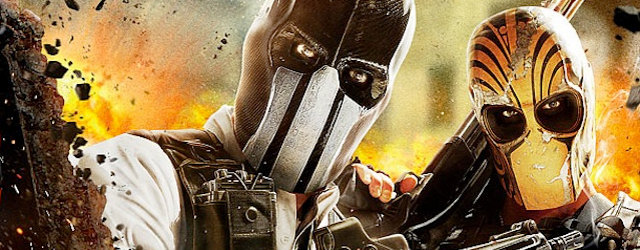[tab:Review]
I am comfortable enough to openly admit that I enjoyed the previous two Army of Two games. They were dumb, bro-fist shooters that focused on cooperative play and terrible jokes. I was prepared for The Devil’s Cartel to be more of the same, with new characters and a new setting. Well, it certainly delivers on having both of those bullet points, but also removes everything that makes the series what it is. The latest entry feels like a step backwards in an already mediocre shooter experience.
The biggest change in The Devil’s Cartel is the replacement of the series’ cheesy heroes Salem and Rios. Their removal might not seem like such a bad thing considering their immense cheesiness, but this actually removes what made the previous games as enjoyable as they were. In their place we get Alpha and Bravo, quite possibly the worst-named duo in gaming ever, while Salem and Rios are instead delegated to supporting roles. Neither of these two new bro-fisters bring the level of charm Salem and Rios deliver, but instead resort to attempting a more serious tone that falls flat in a shooter dominated by sleeve tattoos and hockey masks.
The narrative doesn’t make up for the lack of character interaction either. The plot revolves around Alpha and Bravo on a mission in Mexico to rescue a political prisoner from a drug cartel’s private army. In reality this only gives a backdrop to gun down hordes of brainless enemies over and over, ad nauseum. The locales never feel authentic, and the enemy chatter barely graduates past screaming profanities at the duo and plenty of screams of death. I could have dealt with all the story’s shortcomings if Alpha and Bravo were even a fraction as cheesily-charming as Salem and Rios.
The lack of my favorite protagonists is not the only change though. The Devil’s Cartel has stripped away many of the core game elements the series has become known for. Features such as competitive multiplayer and aggro meter have been severed, and there are no longer moral choices to be made along the way. Instead, gamers are presented with a slogging campaign that runs roughly seven hours of dashing behind cover and shooting down repetitive waves of enemies.
The entire game is broken into checkpoints, set up like an arcade shooting gallery. The layout consists of moving into an area, triggering collections of enemies, then taking cover and mowing them down. Each kill comes attached to a set of points. More creative kills earn more points, which are used to purchase new weapons, attachments and skins for both the character’s firearms and masks. Unfortunately nearly all of the upgrades are purely cosmetic. Even rankings matter very little in the grand scheme of things. Adding a skin to a weapon doesn’t change its base stats, and adding a scope does little to remedy the lackluster shooting mechanics.
The one new feature added to the experience is called Overkill, and it is exactly that. This is a meter that slowly fills up over time. Once full, tapping the left bumper sends both Alpha and Bravo into a frenzied state, making them invulnerable to bullet fire as well as granting infinite ammo. This is a nice way to get out of sticky situations, but never feels like a game-changer. Considering the loss of the aggro meter, it also feels like the rest of the game; a massive step backwards.
Playing cooperatively has always been the highlight of the series, and Devil’s Cartel is no exception. Adding a friend to the mix helps alleviate some of the tedium by letting players get creative in their approach. Sadly that only lasts for a few levels as the design of the experience bottlenecks players down specific paths, eliminating any chance of inventiveness. I never once felt the need for a co-op partner during the campaign. In fact, this is one of the redeeming features of the experience. Partner AI can handle enemies fairly well, never forcing me to babysit them in any section of the game.
The one area of the game does stand out is the visuals. While the core design is nothing to write home about, the sheer destruction brought on by the Frostbite 2 engine is impressive. Watching chunks of concrete tear away and boxes splinter is always impressive in a shooter. It also keeps players on their toes when moving between sources of cover. Visually, the game looks good from a purely technical standpoint. I just wish the design of the environments, and enemies had as much inspiration behind them.
Alpha and Bravo also lack that camaraderie the series has become known for. Neither one is genuinely funny, or even annoying in a sense that can become humorous. They both come across stale in both dialogue and delivery. Audio within the game is good, delivering solid explosions that rattle your surround system. Too bad the music falls flat and serves more as background noise than anything else.
Army of Two: The Devil’s Cartel is a prime example of a series that has a lot in its way. Nothing here drives the experience forward, and instead leaves most of what makes it special behind. Having really enjoyed the first two games, it was difficult walking away from this mess of a sequel. It is unfortunate because the series was finally coming into its own, only to be stripped of everything that made it special. I cannot recommend this entry even for fans of the previous two games. It moves away from what makes the series endearing, all the while still only managing to be a mediocre shooter at best.
Review copy of game provided by publisher. Primary play on Xbox 360.
[tab:Screenshots]
[tab:END]

